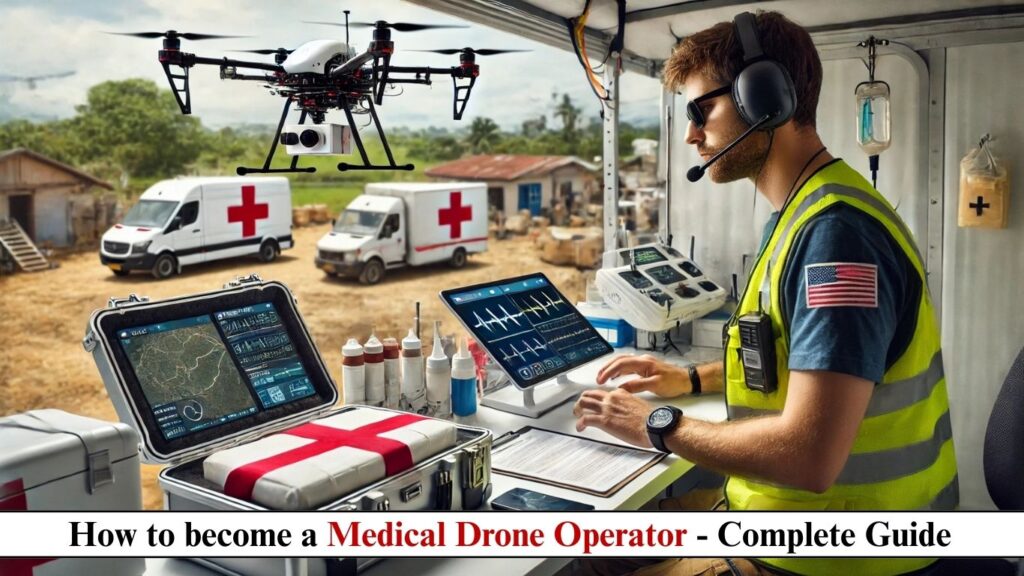
Introduction to Medical Drone Operations
The global medical drone market is projected to reach $1.5 billion by 2028, revolutionizing healthcare logistics through rapid delivery of vaccines, blood supplies, and emergency medications. Medical Drone Operators are skilled professionals who combine aviation expertise, healthcare knowledge, and tech proficiency to save lives through unmanned aerial systems (UAS).
This guide covers:
- Evolution of medical drone technology
- Salary benchmarks worldwide
- Day-to-day operations
- Certification requirements
- Step-by-step career entry
- Future industry trends
Whether you’re a healthcare worker, aviation enthusiast, or tech professional, this guide explains how to launch a career in this high-impact field.
History of Medical Drones
Early Experiments (2000-2010)
- 2004: Drones first used for disaster relief in Indonesia
- 2007: Matternet conceptualizes medical supply drones
- 2010: Haiti earthquake tests emergency drone deliveries
Regulatory Milestones (2011-2018)
- 2014: Rwanda launches Zipline’s blood delivery network
- 2016: FAA Part 107 allows commercial drone operations
- 2018: First US organ transport via drone (University of Maryland)
Modern Era (2019-Present)
- 2020: COVID-19 accelerates vaccine drone deliveries
- 2022: FAA approves beyond visual line of sight (BVLOS) flights
- 2024: AI-powered emergency response drones deploy defibrillators
Medical Drone Operator Salary (2024)
| Experience Level | Average Salary (US) | Global Hotspots |
|---|---|---|
| Entry-Level (0-2 yrs) | $45,000-$65,000 | Rwanda, Malawi |
| Mid-Career (3-5 yrs) | $65,000-$90,000 | Germany, Australia |
| Senior (5+ yrs) | $90,000-$140,000 | UAE, United States |
Industry Variations:
- Highest Paying: Organ transport specialists (+30%)
- Fastest Growing: Disaster response operators (45% annual demand)
Bonus Earnings:
- Night shift premiums for emergency operations
- Hazard pay for conflict zone deployments
Roles & Responsibilities
1. Mission Planning
- Calculate payload vs. battery life tradeoffs
- Map no-fly zones near hospitals
- Coordinate with air traffic control
2. Healthcare Logistics
- Load temperature-controlled containers (vaccines/blood)
- Verify chain of custody for regulated biologics
- Implement RFID tracking for high-value cargo
3. Flight Operations
- Conduct pre-flight diagnostics on:
- Propulsion systems
- Parachute recovery
- Emergency beacons
- Monitor real-time telemetry during flights
4. Regulatory Compliance
- Maintain FAA Part 107/UK CAA permissions
- Document incident reports per WHO guidelines
- Renew medical cargo handling certifications
5. Emergency Response
- Deploy AED drones for cardiac arrests
- Deliver anti-venom to remote areas
- Support warzone medevac operations
Required Qualifications
Education & Training
| Background | Career Path | Top Programs |
|---|---|---|
| Aviation | Pilot Operations | Embry-Riddle Aeronautical University |
| Biomedical | Cargo Specialization | Johns Hopkins Medical Drone Initiative |
| Engineering | Drone Maintenance | MIT UAS Certificate |
Technical Skills
- Drone Models: Matternet M2, Zipline Fixed-Wing
- Software: DroneDeploy, Kittyhawk, Airmap
- Healthcare Protocols: WHO cold chain standards
Certifications
- FAA Part 107 (US) / EASA A1/A3 (EU)
- Medical Drone Operator Certification (AMTC)
- Hazardous Materials Air Transport (IATA)
- Wilderness First Responder (WFR) for remote ops
How to Get Started: 5-Step Roadmap
Step 1: Build Core Knowledge
- Complete FAA Part 107 course ($150-$300)
- Study WHO Technical Series on Drone Deliveries
- Practice on DJI Mavic (entry-level medical drones)
Step 2: Gain Hands-On Experience
- Entry Paths:
- Zipline Flight Operator (22−22−35/hr)
- Hospital Logistics Technician
- Alternative Routes:
- Military drone operations
- Disaster relief volunteering
Step 3: Specialize
- High-Demand Niches:
- Cryogenic organ transport
- Maritime medical deliveries
- AI swarm coordination
Step 4: Earn Advanced Certs
- Night Operations Endorsement
- BVLOS Certification
- UAS Medical Payload Mastery (AMTC)
Step 5: Secure Target Roles
- Employers Hiring Now:
- Zipline (Africa/US)
- Swoop Aero (Oceania)
- UPS Flight Forward (US)
Future Scope & Trends
1. Technology Advances
- 2025: Hypersonic medical drones (500km range)
- 2027: Nanodrone swarms for in-body drug delivery
2. Regulatory Evolution
- ICAO global medical drone standards
- Automated air traffic control integration
3. New Applications
- Elderly care: Prescription deliveries to senior communities
- Pandemic response: Autonomous testing kit distribution
4. Market Growth
- $2.3B industry by 2030 (36% CAGR)
- India/SE Asia emerging as key markets
5. Career Innovations
- Drone Traffic Controllers for medical UAS
- Telemedicine Integration Specialists
Conclusion: Is This Career Right For You?
✅ Ideal Candidate:
- Passion for aviation + healthcare
- Comfort with high-pressure scenarios
- Mechanical aptitude + tech savvy
🚀 Action Plan:
- Get Part 107 certified within 3 months
- Volunteer for disaster drone orgs
- Specialize in one medical payload type
- Network at AUVSI Medical Drone Summit
With 1 million lives potentially saved annually by medical drones by 2030, operators will play a mission-critical role in global health.
Want our free checklist for medical drone pre-flight inspections? Comment below!
Questions about transitioning from commercial to medical drone ops? Ask here!













Post Comment